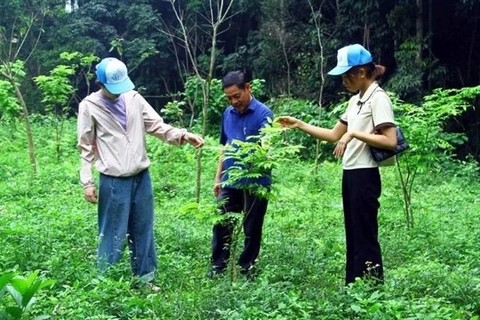
During 2023-2025, the central province of Quảng Bình received VNĐ235 billion (US$9.5 million) for its efforts to reduce greenhouse emissions, contributing to managing and protecting forest sustainably. — VNA/VNS Photo
The establishment of a carbon credit market will help enterprises gain a competitive edge when selling products to foreign countries, particularly those with strict requirements on sustainability, according to insiders.
Dr. Trần Đại Nghĩa, head of the Department of Natural Resources and Environment Economics under the Institute of Policy and Strategy for Agriculture and Rural Development stressed that the carbon credit market aims at creating an additional financial channel to validate the emissions commitment.
Carbon labels could be attached to goods which are produced with “carbon footprint” technologies, or in accordance with low-emission method, he said, adding they will not be imposed additional taxes in the European Union (EU) when the bloc applies the Carbon Order Adjustment Mechanism (CBAM).
Evaluating the impacts of CBAM on Việt Nam, Director of Training and Sustainable Development at Intertek Việt Nam Đặng Thanh Long held that as CBAM taxes imports based on their carbon intensity to prevent carbon leakage, Việt Nam should form its carbon credit market soon to avoid higher export costs, and mitigate the impact on local enterprises.
Along with legal frameworks, and ways to operate the carbon credit market, Việt Nam should prepare human resources for the industry, Director of the VOS Harvest Ecosystem Company Limited Lê Hoàng Thế said. The country plans to pilot a carbon credit exchange next year, making it essential to train a professional brokerage force for carbon trading.
Prof.Dr. Võ Xuân Vinh from the University of Economics, HCM City said the development of a carbon credit market will bring benefits for the agricultural sector.
The sector, he said, is a leading sector in selling carbon credits, adding last year marked a significant milestone for the forestry sector as Việt Nam successfully sold 10.3 million forest carbon credits (10.3 million tonnes of CO2) for the first time through the World Bank (WB) for US$51.5 million.
He expressed his hope that Việt Nam will actively engage in the global market, and will sell an additional 5 million credits next year. Forest carbon sequestration is expected to be a hot market for Việt Nam in the coming time.
Rice cultivation is also said to benefit from the carbon credit scheme. Việt Nam is accelerating a project to develop one million hectares of high-quality and low-carbon rice fields in the Mekong Delta region.
By adopting more sustainable practices, the project is expected to help lower emissions associated with rice farming, and farmers could earn additional income from selling carbon credits if emission reductions are effectively realised.
However, experts said a specific and rational legal framework should be sketched out to set the price of each carbon credit, while it is also necessary to pen regulations on profit-sharing mechanisms when trading carbon credits attached to growing rice.
Việt Nam received a $51.5 million payment for verified emissions reductions (“carbon credits”) for reducing deforestation and forest degradation (commonly known as REDD+) and for enhancing carbon stored in forests through reforestation and afforestation in March, making it the first country in the East Asia Pacific region to receive a results-based payment from the World Bank’s Forest Carbon Partnership Facility (FCPF).
The payment was made to Việt Nam for reducing 10.3 million tonnes of carbon emissions between February 1, 2018 and December 31, 2019. It is the largest single payment to date made by the FCPF for verified and high integrity carbon credits. The payment will benefit 70,055 forest owners and 1,356 communities near the forest, to be distributed according to a robust benefit sharing plan designed through a consultative, participatory, and transparent process.
Việt Nam’s emission reduction programme protects most of the country’s tropical forests, covering 3.1 million of the 5.1 million hectares of land in the programme area. These forests are of significant ecological importance, encompassing five internationally recognised conservation corridors. The area is also home to 12 per cent of the country’s population, including 13 ethnic minority groups and many forest-dependent communities.
Almost one-third of people in the region live below the national poverty line. Through improved forest management, investment in the forest sector, and enhancement of agricultural policies, the programme is increasing both the extent and quality of forest cover in collaboration with local communities. — VNS